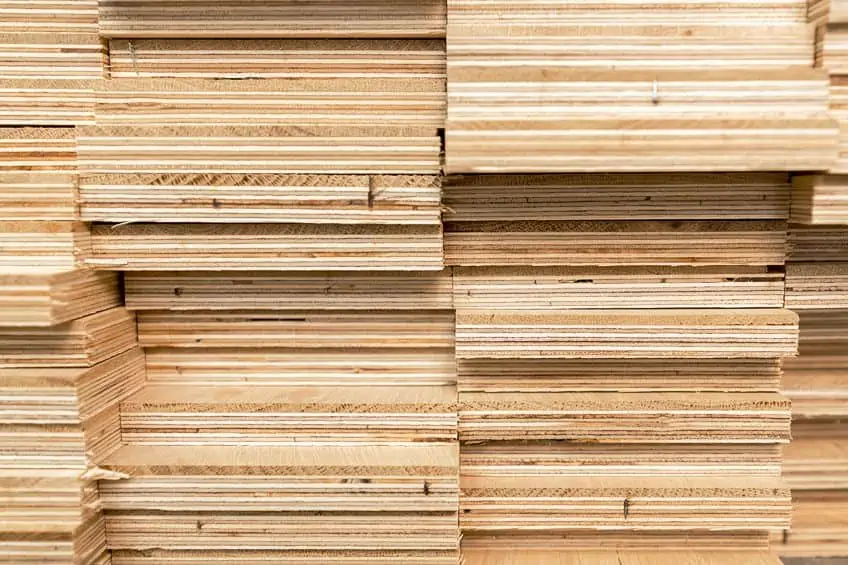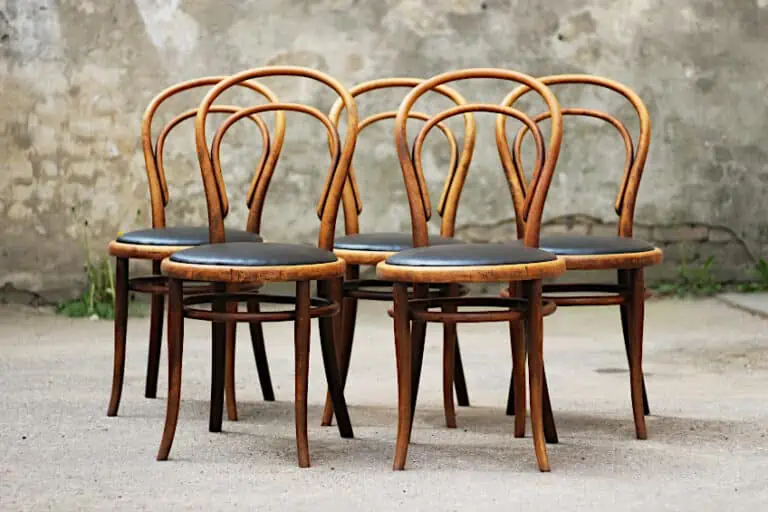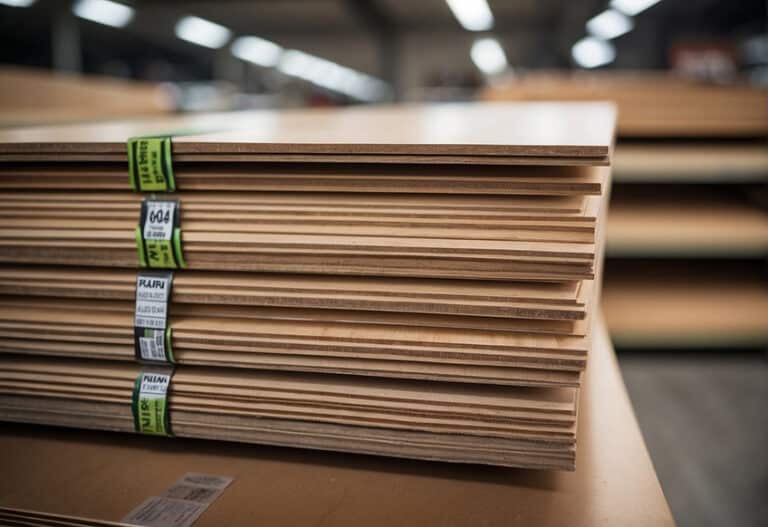Plywood Weight – How Much Does a Sheet of Plywood Weigh?
When considering wood for a project, it can be challenging to choose which material is best suited for the job. These days, most American homes are constructed from engineered woods and similar “synthetic” materials, which are often stronger, lighter, and cheaper than their conventional counterparts. One of the most popular of these materials is plywood, which can vary considerably in weight, color, size, tolerances, and composition. Let’s have a deeper look at plywood and its characteristics.
Table of Contents
What Affects the Weight of Plywood?
There are a number of factors that contribute toward plywood weight per square foot. Plywood is what is known as an engineered wood, which essentially means that it is comprised of a number of thin layers of wood called veneers. These veneers are stuck together through a combination of chemicals and heat treatment, forming the rigid and dense solid material you know and love. But how much does a sheet of plywood weigh? Let’s have a look at some of the factors that affect the weight of this material.
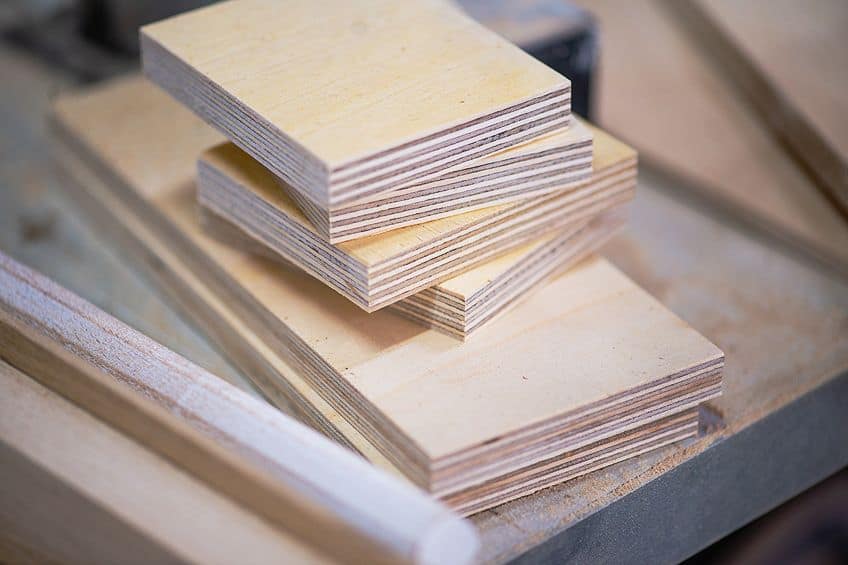
Density
Density is one of the factors that play a huge role in the weight of any given object. Density is typically created through the process of compression, which can be achieved through artificial means or simply through the force of gravity. In the case of plywood, density is created by combining a number of thin pieces of wood known as veneers – which are so thin that they can be rolled up in some instances – and joining them together at their faces.
Once fused together, this new solid wood object is placed in a heat press and compressed in order to achieve greater rigidity and density, which ultimately increases its weight.
Adhesives
You might think that the majority of the weight of plywood comes from the layers of veneer, and you would not be far off considering the sheer volume of veneer wood that goes into a piece of plywood board. However, the reality is that the chemical adhesives used to bond these sheets of veneer together play a far bigger role in the overall weight of the plywood.
Depending on how much veneer is used in a specific batch, these sheets are often saturated in these chemical adhesives, and just as wet wood is heavier than dry wood, adhesives account for more than half of plywood’s overall weight. This is due to there simply being more matter present.

Wood Compounds
As we mentioned previously, plywood is categorized as an engineered wood, which simply means that it is not solid lumber that has been cut and shaped directly from the trunk of a tree. Engineered woods are versatile because anything can be added to them to provide them with your desired qualities. A good example is adding a thin rubber compound or a layer of synthetic compounds to increase the flexibility of the plywood.
While this is certainly useful and has virtually endless possibilities, it does increase the weight of the object.
In fact, if you were interested in having conventional hardwood as the face layer of your plywood, this would also increase the weight of the wood. Depending on the manufacturer or supplier, plywood often has pre-existing formulas to ensure that your plywood is suited for whichever application you will be using it for, all while remaining relatively lightweight and rigid.
Finishing and Processing
Something that you might not think about immediately is the processes that these woods are subjected to after they have been put together. Plywood is used in a variety of applications, ranging from heavy-duty construction to crafting and even furniture design.
Once the wood has been cut to size, it is often reshaped and sanded down to fit a specific application, and in the process, it can lose a few pounds. You would be surprised at just how much usable material can be stripped from any type of wood during the sanding process, but this usually does not affect the integrity of the overall workpiece it is being applied to due to the remarkable density of plywood.
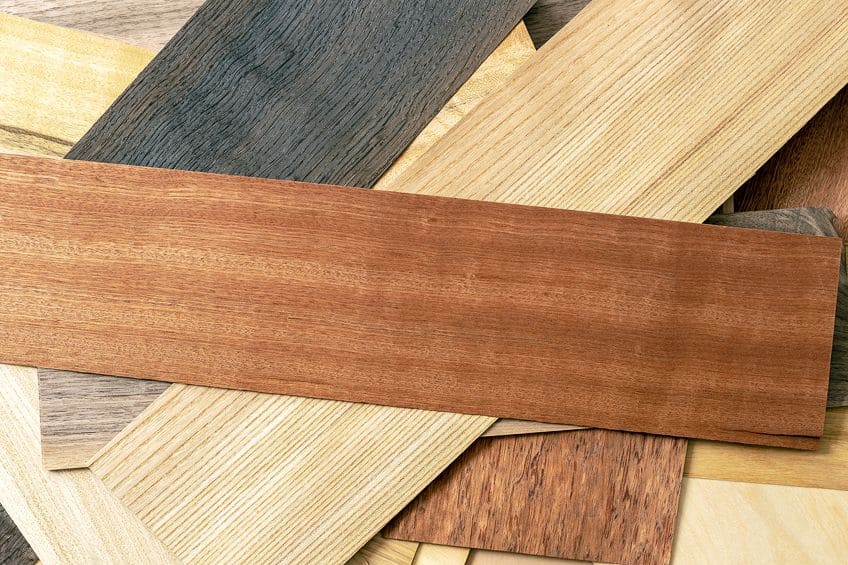
In contrast to causing plywood to lose weight, adding finishes like varnish, paint, resin, laminate, or waterproofing can dramatically increase the weight of any given piece of plywood.
This is due to the fact that these coatings saturate the wood fibers in the plywood. In fact, adding these finishes can greatly increase the longevity of your wood and ultimately your workpiece, thus being well worth the increase in weight. These processes can be used in combination with one another, as processing and shaping wood often results in the weight of the wood being reduced, whereas adding finishes can often make up for the overall loss of material during the process.
What Are the Standard Dimensions of Plywood?
Plywood can be manipulated into a variety of shapes and forms. This means that there are some standard measurements for certain applications, although the standard measurements used across most disciplines are four feet by eight feet (4’ x 8’) from most manufacturers of this type of wood.
This is largely due to it coinciding perfectly with dimensions for applications such as joists, trusses, and load-bearing applications for drywalls. As we covered previously, there are different types of plywood for different applications and as a result, they can often vary considerably in weight. Let’s have a look at some of the different types of plywood available today and how much they weigh respectively with a plywood weight chart.
Plywood Weight Chart
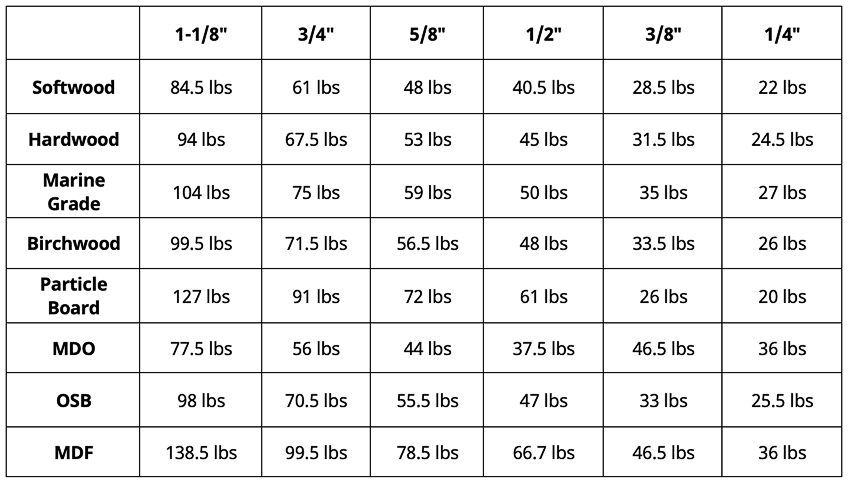
How Do You Calculate the Weight of Plywood?
As we covered earlier, there are a variety of characteristics belonging to a particular piece of plywood that can influence its density. In addition to the dimensions of the plywood as shown in the above chart, plywood weight is affected by things such as the density of the veneer, the saturation of wood fibers by adhesives used in the bonding process, as well as finishes and sanding. Typically, the latter won’t come into play for those purchasing plywood for domestic purposes, but those in the commercial industry can specify the exact dimensions needed when commissioning a set of boards to be created.
The formula for how to calculate the weight of plywood is simply density multiplied by volume (W= D x V). If you need a refresher on how to determine the values of the aforementioned dimensions, remember that volume is equal to length multiplied by breadth multiplied by height (V=L x B x H).
Density is entirely dependent on the number of veneer sheets used in the construction of any given piece of plywood board, and since it is useful to have this information on hand, here are the types of veneers used to create the most commercially available types of plywood and their implied weight contribution. Note that the PSI refers to the number of pounds per square inch.
- Poplar veneer – 1146.4 PSI
- Finger joint – 1212.542 PSI
- Eucalyptus – 1322.77 PSI
- Birchwood – 1543.24 PSI
- Benuang – 837.757 PSI
There are other aspects of plywood that can affect its weight during and after the manufacturing process, but two of the most common factors are moisture and the compression ratio of any given set of board. These factors affect the density of the finished product and therefore ultimately affect the weight. Calculating plywood weight can prove to be a tedious task if you don’t have all of the information available to you. Thus, when you are commissioning a board to be made or purchasing it outright, be sure to gather all of the information you have so that you can calculate plywood weight.
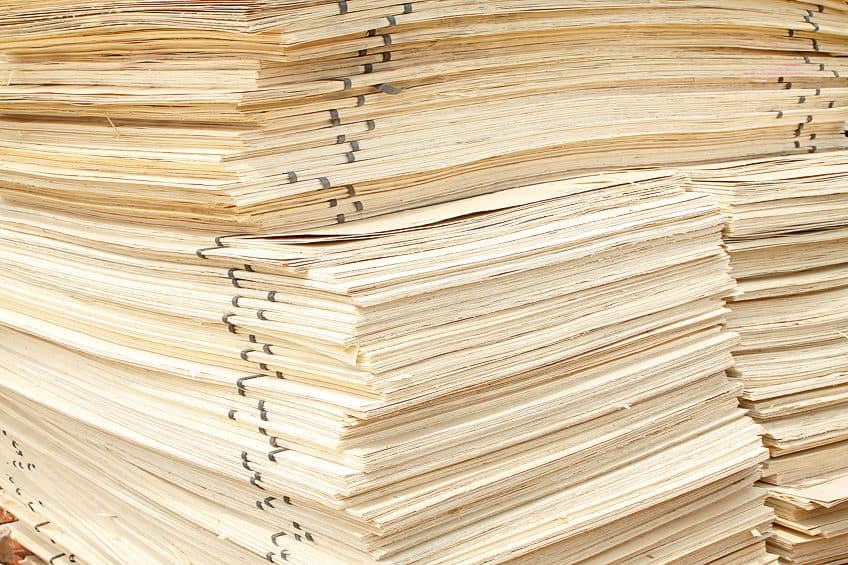
How Much Weight Can Plywood Hold?
Usually, when someone poses the question, “How much does a sheet of plywood weigh?”, the follow-up question is often how much weight can plywood support? This is a tricky question as there are loads of strength calculators online that will give you roughly the same answer. Regardless of their individual accuracy, you should have some information available so that you can even begin to use these calculators.
This being said, let’s have a look at some of the factors that affect the load-bearing ability of plywood.
Thickness
At some point, you have torn up a piece of paper in your hands – pretty easy right? Well, this is given, but it is significantly harder to tear an entire reem of paper apart in the same manner. What is the difference? There is quite obviously more paper in the equation and therefore more weight, which means that there is an increase in overall density.
This example is a one-to-one parallel with veneers that are used to create plywood, where the more veneers used in the construction of plywood, the thicker the overall finished product will be. This means that the weight the plywood is able to hold will be much greater. As we covered previously, plywood is made in a variety of thicknesses, meaning that its load-bearing capabilities differ.
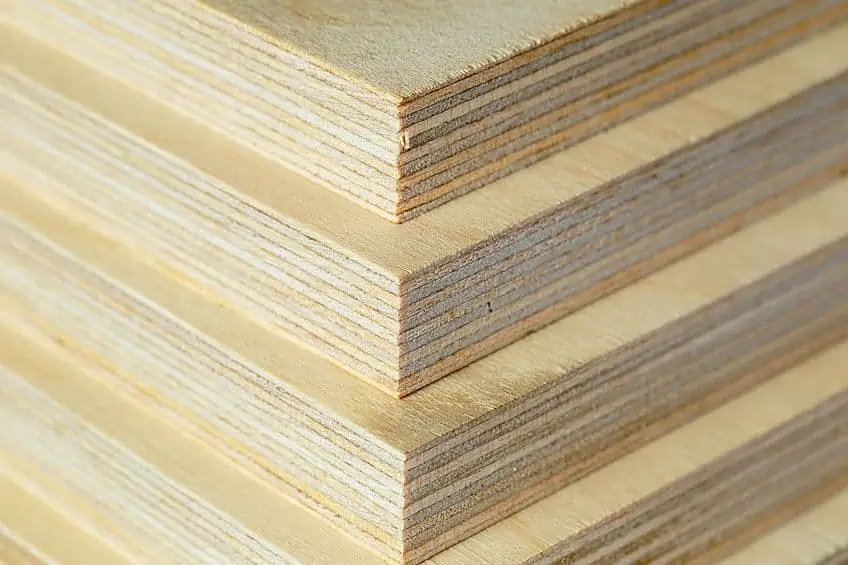
The Type of Woods Used
Another factor that plays a part in answering, “How much weight can plywood support?”, is the types of woods used in their construction. As you know by now, there can be one type of wood used or multiple materials and woods used to give the plywood certain characteristics.
Outside of this, you should also keep in mind that plywood considered to be softwood does not have the tensile strength and/or loadbearing ability of plywood characterized as hardwood.
Hardwood plywood is heavier due to its denser wood fibers and will be able to hold an overall greater load in comparison to softwood plywood. Knowing how to identify the differences between these types of plywood can save you time, money, and begrudgingly tearing apart a workpiece you have unwittingly constructed with the incorrect type of wood.
Direction of Wood Grain
The weight and density of plywood can play a huge role in how much weight it can hold, but this means that the grain direction is often overlooked. Remember that when working with wood, you have to consider how certain forces will act on it, and what characteristics it already has that you can use to your advantage.
The grain of any piece of wood, whether it be engineered or otherwise, can be exploited for load-bearing purposes. This is done by running the load or contact point of the wood parallel to the grain of the wood instead of across it. A simple way to think about it is by picturing how easy it is to chop a two by four in half by cutting across the grain as opposed to with it (vertically). Remember that the grain, thickness, and density of plywood influence its overall loadbearing ability.
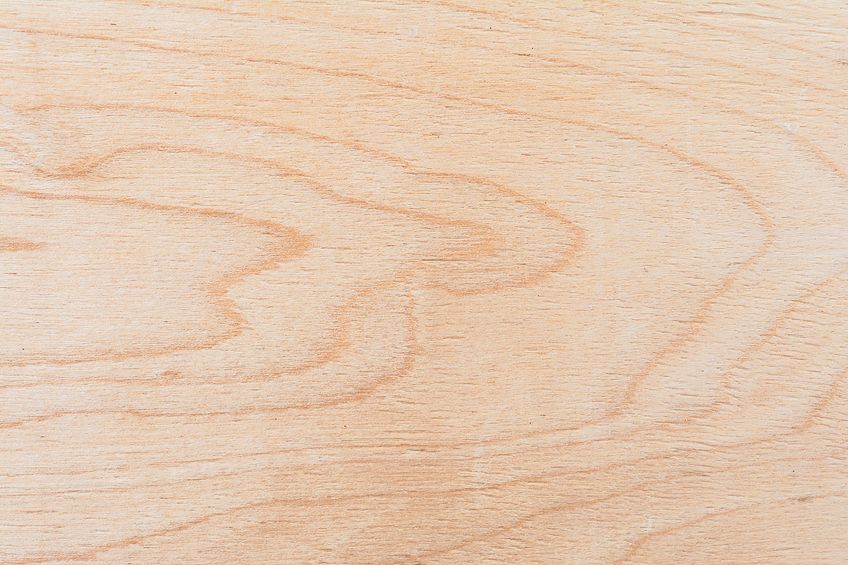
What Type of Plywood Should You Use?
Now that you know how to calculate the weight of plywood, you are probably wondering what kind of plywood is best for you. Once you have taken some of the characteristics we have covered previously into account, it can be a difficult decision to make, but this can be made easier by asking yourself a few questions. Here are a few things you should consider when choosing plywood for commercial or domestic use, which could save you some hard-earned money and some choice words should you end up needing to tear some boards out.
Application
What purpose your plywood will be serving is as important as the weight and density of your plywood, as the two often go hand in hand. Consider what forces will be acting on your plywood and what kind of load it will be bearing, if any.
You have the chance to over- or under-compensate for these issues, so planning ahead and taking measurements might seem obvious to some, but when you are caught up in a project and things are time-sensitive, it’s an easy mistake to make. Roofing structs and under-floor supports require denser plywood (typically hardwood) because it is essential to structural integrity.
Therefore, you should check the veneer count of the plywood you are purchasing as well as the type of veneer that has been used to create it.
For example, if you need wood with some flexibility or extra rigidity, you need to look for those specific qualities when you are at the lumber yard or consulting with your supplier. The last thing you want in the middle of a gathering is your floor collapsing in on itself.
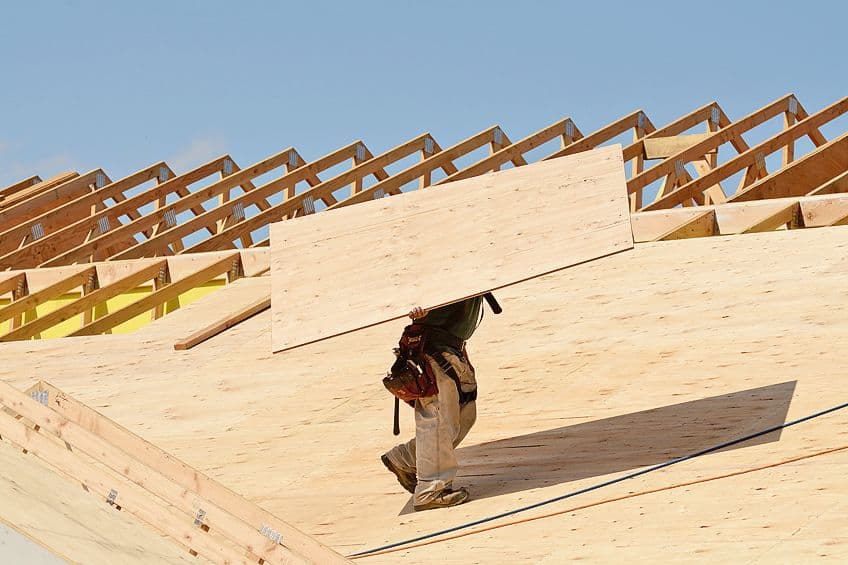
Environment
Things like plywood weight per square foot can matter very little if your choice of wood is not well suited for the environment you will be using it in. When most of us think of the word “environment”, we think of the outdoors, but as much as ensuring that your wood can handle the elements is important, you should also consider other factors. These include the overall humidity indoors, the likelihood of rapid changes in temperature (which can cause wood to crack and split), and even how the wood will react with things it will come into contact with regularly.
All of these factors can occur both indoors and outdoors, but this problem is easily solved if you are able to treat your plywood.
The good news is that all plywood can be treated or will be sold pre-treated for a specific application such as marine plywood, which can be used underwater or where moisture will be present constantly. The bad news is that different types of veneer and artificial plywood composites catalyze protective coatings differently, meaning that you should be aware of what you will be working with in addition to the plywood.
Versatility and Weight
Sometimes buying something for a specific purpose is necessary for our day-to-day lives, but when it comes to plywood, having a board that you are only going to use once can put a hole in your pocket pretty quickly. This being said, it is in your best interest to get the most “bang for your buck”, as they say.
Therefore, consider what applications besides your immediate needs that you might be able to use a certain type of board for. This will allow you to purchase in bulk (which can work out cheaper) and repurpose any unused wood that you have cut off for things around the home. This isn’t always easy, however, as the weight of ¾-inch plywood might not always be conducive to repurposing.
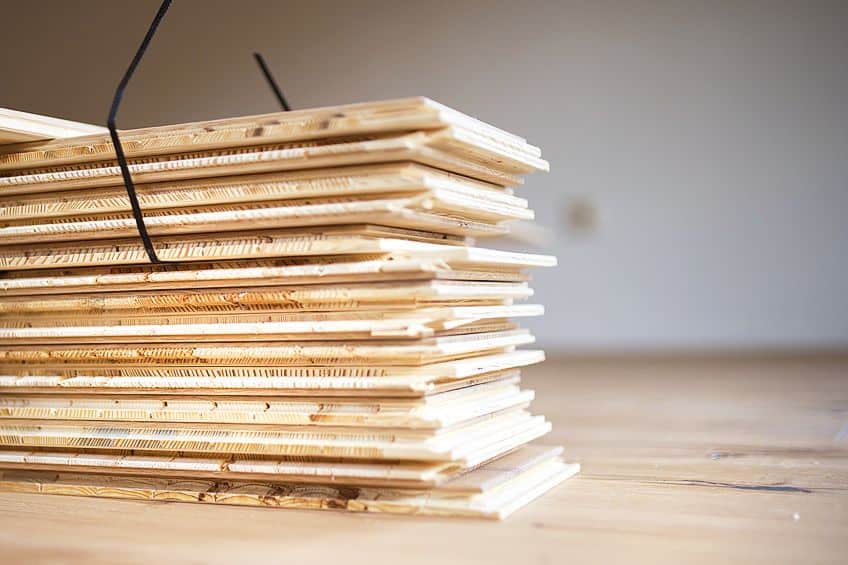
However, if you are working with the weight of 1/2 inch plywood, this may be perfect for filling up edges or simple crafting, as it is in that weight sweet spot. This means that you might have to use your imagination to get your money out of a specific batch of boards, especially if you don’t know exactly how much you will need for a specific project or workpiece. If you find yourself working with 3/8-inch plywood, you will find that 3/8 plywood weight is conducive to a lot of projects and DIY ideas.
Now that you know how to calculate the weight of plywood, how much weight each type can handle respectively, what types of veneer there are, and how to choose the right type of plywood for you, it is time to go out there and start your next project. Remember that preparation always beats having to tear boards out from their spots, and as always, safety first!
Frequently Asked Questions
What Is the Weight of 3/4 Plywood?
The weight of 3/4 plywood is entirely dependent on the size of the board, but for the sake of simplicity, it is generally agreed that the weight of 3/4 plywood is 61 lbs.
Is Plywood Strong?
Hard plywood is agreed to have better load-bearing ability compared to soft plywood, but both types of plywood have a relatively good tensile strength. In fact, both can be implemented in a number of environments and a wide variety of applications depending on the veneer that is used to construct them and their respective coatings and finishes.
Can Plywood Get Wet?
Although plywood can get wet, allowing untreated plywood to get wet can result in wood splitting, warping, or cracking. If you know that your plywood will be exposed to the elements, it is suggested that you either invest in plywood designed to withstand those particular forces (such as marine plywood for moisture-rich environments) or consider coating your plywood with an appropriate protective layer.
How Much Does a Sheet of Plywood Weigh?
There are a lot of factors that influence the weight of a sheet of plywood, such as the number of adhesives used and the number of veneers present in the final product. There are other factors such as finishes, moisture content, and the size of the plywood board that can contribute towards its weight as well.

I have been into woodworking since 2005 and woodturning since 2011. Because of my love for wood and woodworking, I started woodhappen.com to teach other enthusiasts about how to finish and seal wood, the best woodworking tools, the different types of wood, and everything else related to woodworking! Read more about me here.

